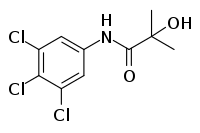AA560
AA560 is an orally active nonsteroidal antiandrogen (NSAA) that was developed in Japan and was first described in the literature in 1977 but was never marketed.[1][2][3] It is an anilide derivative and analogue of the NSAA flutamide, and shows greater in vivo antiandrogenic potency than does flutamide.[1][2] Similarly to flutamide, AA560 is a selective antagonist of the androgen receptor (AR) and consequently shows progonadotropic effects by increasing levels of gonadotropins and testosterone via disinhibition of the hypothalamic-pituitary-gonadal axis.[1][2][4]
 | |
| Clinical data | |
|---|---|
| Other names | AA-560; N-(2-Chloromethyl-2-hydroxypropionyl)-3,4,5-trichloroaniline |
| Routes of administration | By mouth[1] |
| Drug class | Nonsteroidal antiandrogen |
| Identifiers | |
IUPAC name
| |
| CAS Number | |
| PubChem CID | |
| ChemSpider | |
| Chemical and physical data | |
| Formula | C10H10Cl3NO2 |
| Molar mass | 282.545 g/mol g·mol−1 |
| 3D model (JSmol) | |
SMILES
| |
InChI
| |
See also
References
- Shida, Keizo; Yamanaka, Hidetoshi; Koya, Atsushi; Wakabayashi, Katsumi; Mori, Hiroshi; Shibata, Kenyu; Shimazawa, Eiichiro (1980). "Action of a novel nonsteroidal antiandrogen, AA560". Endocrinologia Japonica. 27 (1): 69–76. doi:10.1507/endocrj1954.27.69. ISSN 0013-7219.
- Yamanaka, Hidetoshi; Koya, Atsushi; Imai, Kyoichi; Nakai, Katsuyuki; Yuasa, Hisako; Sugiyama, Yuko; Shida, Keizo; Wakabayashi, Katsumi (1981). "Effect of AA560 (a nonsteroidal antiandrogen) implantation in the hypothalamus on gonadotropin secretion in male rats". Endocrinologia Japonica. 28 (6): 819–822. doi:10.1507/endocrj1954.28.819. ISSN 0013-7219.
- Singh SM, Gauthier S, Labrie F (2000). "Androgen receptor antagonists (antiandrogens): structure-activity relationships". Curr. Med. Chem. 7 (2): 211–47. doi:10.2174/0929867003375371. PMID 10637363.
- Annual Reports in Medicinal Chemistry. Academic Press. 16 September 1986. pp. 181–. ISBN 978-0-08-058365-5.
This article is issued from
Wikipedia.
The text is licensed under Creative
Commons - Attribution - Sharealike.
Additional terms may apply for the media files.